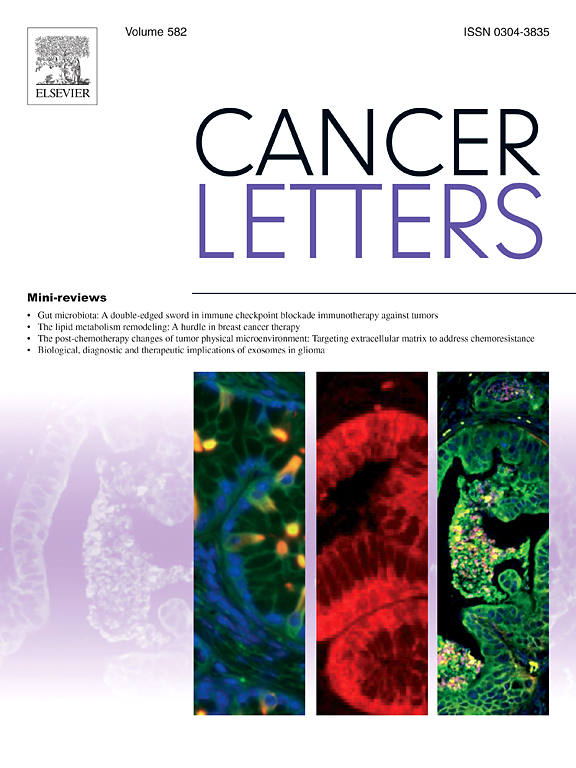Sonrotoclax (BGB-11417) synergistically amplifies the radiotherapy-elicited anti-tumor immune response
IF 9.1
1区 医学
Q1 ONCOLOGY
引用次数: 0
Abstract
Escape from apoptosis is one of the main hallmarks of cancer. The imbalance of BCL-2 family members is a key factor leading to radiotherapy resistance. Targeting BCL-2 can overcome radiotherapy resistance by promoting apoptosis. Nevertheless, the function of BCL-2 in regulating the tumor immune microenvironment (TIME) is still not well understood. Herein, we discovered that the specific BCL-2 inhibitor sonrotoclax (BGB-11417) boosted the effectiveness of radiotherapy in an immune-mediated manner. Using flow cytometry, we found that sonrotoclax combined with radiotherapy polarized tumor-associated macrophages (TAMs) toward the M1-type and promoted the infiltration of Gzmb+ CD8+ T cells into the tumor. Mechanistically, we demonstrated that the combination of sonrotoclax and radiotherapy induced immunogenic ferroptosis of cancer cells by inhibiting GPX4 expression, released tumor-associated damage-associated molecular patterns (DAMPs) and subsequently activated the NF-κB pathway in TAMs. Moreover, the combination therapy also led to aberrant cytosolic DNA abundance and activated the cGAS-STING pathway in cancer cells, leading to the release of type I interferons and enhanced activation of CD8+ T cells. Meanwhile, the activation of cGAS-STING pathway also led to the upregulation of PD-L1 expression. Further combination of sonrotoclax and radiotherapy plus anti-PD-L1 exerted the most significant anti-tumor effects. Overall, our study indicated that sonrotoclax enhanced the anti-tumor immune response of radiotherapy through non-apoptotic roles of BCL-2, and shed light on the further clinical evaluation of the triple combination therapy of sonrotoclax, radiotherapy and immunotherapy.
Sonrotoclax (BGB-11417)可协同增强放疗引发的抗肿瘤免疫反应
细胞凋亡逃逸是癌症的主要标志之一。BCL-2家族成员失衡是导致放疗耐药的关键因素。靶向BCL-2可通过促进细胞凋亡来克服放疗耐药。然而,BCL-2调控肿瘤免疫微环境(TIME)的功能尚不清楚。本文中,我们发现特异性BCL-2抑制剂sonrotoclax (BGB-11417)通过免疫介导的方式提高了放疗的有效性。通过流式细胞术,我们发现sonrotoclax联合放疗使肿瘤相关巨噬细胞(tumor associated macrophages, tam)向m1型极化,促进Gzmb+ CD8+ T细胞向肿瘤浸润。在机制上,我们证明sonrotoclax联合放疗通过抑制GPX4表达,释放肿瘤相关损伤相关分子模式(tumor-associated damage-associated molecular patterns, DAMPs),随后激活tam中的NF-κB通路,诱导癌细胞免疫原性铁凋亡。此外,联合治疗还导致细胞质DNA丰度异常,激活癌细胞中的cGAS-STING通路,导致I型干扰素释放,增强CD8+ T细胞的活化。同时,cGAS-STING通路的激活也导致PD-L1表达上调。sonrotoclax进一步联合放疗加抗pd - l1抗肿瘤效果最为显著。综上所述,我们的研究表明sonrotoclax通过BCL-2的非凋亡作用增强了放疗的抗肿瘤免疫应答,为sonrotoclax、放疗和免疫治疗三联疗法的进一步临床评价提供了依据。
本文章由计算机程序翻译,如有差异,请以英文原文为准。
求助全文
约1分钟内获得全文
求助全文
来源期刊

Cancer letters
医学-肿瘤学
CiteScore
17.70
自引率
2.10%
发文量
427
审稿时长
15 days
期刊介绍:
Cancer Letters is a reputable international journal that serves as a platform for significant and original contributions in cancer research. The journal welcomes both full-length articles and Mini Reviews in the wide-ranging field of basic and translational oncology. Furthermore, it frequently presents Special Issues that shed light on current and topical areas in cancer research.
Cancer Letters is highly interested in various fundamental aspects that can cater to a diverse readership. These areas include the molecular genetics and cell biology of cancer, radiation biology, molecular pathology, hormones and cancer, viral oncology, metastasis, and chemoprevention. The journal actively focuses on experimental therapeutics, particularly the advancement of targeted therapies for personalized cancer medicine, such as metronomic chemotherapy.
By publishing groundbreaking research and promoting advancements in cancer treatments, Cancer Letters aims to actively contribute to the fight against cancer and the improvement of patient outcomes.
 求助内容:
求助内容: 应助结果提醒方式:
应助结果提醒方式:


